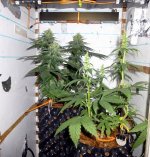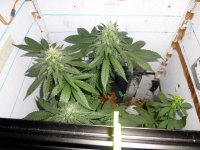FYI, the kelvin range does not tell you the output of the light source. It doesn't help much to give you an idea of the quality of the light.
You can't compare LEDs to CFLs because LEDs have a very different type of light output. White Leds have a much much better quality of light than CFLs, that's why you are seeing better results under the Leds.
Floro's emit "peaks" of wavelengths at a few wavelengths and they are really not ideal peaks for growing. Yes, they do work somewhat since plants can adapt to crappy light sources.
Leds on the other hand emit a "wide-spectrum" type of light. If you take a look at a white led spectral analysis over a cfl spectral analysis you will see what I'm talking about. Leds cover a broad range of wavelengths as a gradual curve from blue to red.
Yes, white leds will always grow plants better than crappy floroescents do.
I know you know this, so chalking your reply up to being high, and not clarifying what you mean-lol.
Not ALL LEDs emit wide spectrum- only whites. And not all cfls are crappy. HO T5 aquarium bulbs rock it just fine + plus they cover considerably bigger footprint for < half the price of today's cost of quality neutral/warm white LEDs.
That said, you now I am a fan of where LEDs are finally at.
Analogue, how big a footprint are the whites throwing, and could they have been a bit farther apart?





